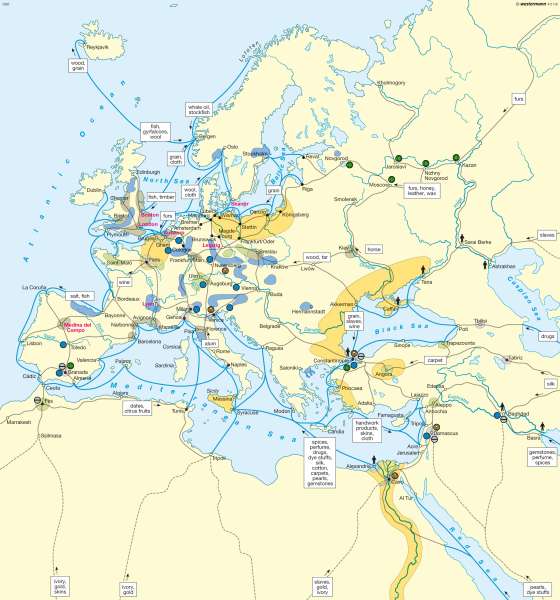Trade and economy in the 15th century
Europe - Middle Ages
978-3-14-100790-9 | Page 31 | Ill. 3

Information
The map shows patterns of trade and commerce in Europe at the end of a medieval expansion phase. Trade was largely in the hands of the Hanseatic League (primarily in Central Europe and the North and Baltic Sea regions) and the Italian City Republics, most notably Venice and Genoa (primarily in the Mediterranean region). At the end of the 15th century, the focus of trading activity shifted to the Atlantic following the discovery of America and new sea routes to Asia. The decline of important players in the medieval trade sector went hand in hand with the creation of new forms of commerce and trade which exhibited features of early capitalism — as represented by the Fuggers in Augsburg and the Medicis in Florence.Trade and business activity gave impetus to the process of geographic differentiation in Europe during the Middle Ages. Rural regions were predominantly agrarian in the 15th century. They served as producers of foodstuffs and suppliers of agricultural raw materials for commercial use. Only those regions with particularly favourable natural environments, such as the Nile Delta and Sicily, were integrated into the expanding trade network.
Cities engaged in trade, commerce and mining. Those that were not seats of ruling potentates depended on commerce as a means of enhancing their prospects for development. In addition to the mining areas in the uplands (such as Goslar in the Harz Mountains), other regions specialized in the production of cloth and textiles (south-eastern England, northern France, Flanders, southern France, northern Italy). Major trading centres and trade fair sites played an important role within the network of cities.
Historical roots
In the ancient world, European trade and commerce were concentrated primarily in the coastal areas of the Mediterranean region. After the last of the Crusades, cities such as Venice and Genoa assumed a dominant role in Mediterranean trade. They profited from their experience in trade in Oriental goods, from the increasing importance of banking and credit and, following the demise of major competitors (the Byzantine Empire), from their monopoly status. By virtue of their strength as sea powers, Venice and Genoa were able to pursue an often militant expansion policy.
Two focal points of trade and commerce had emerged in the North and Baltic Sea regions between the 9th and 11th centuries: Danish and Norwegian trade with Western Europe and Swedish trade with Asia Minor via Russia. The Hanseatic League was founded as a cooperative alliance of German merchants in the 11th century. It soon expanded its sphere of influence into the southern Baltic region through German colonization of territories to the east. Although the Hanseatic League differed from the Italian City Republics as a cooperative alliance of cities, its significance to trade was comparable. The most important trading hubs were Lübeck and Bruges. During its years of bloom in the 13th and 14th centuries, the sphere of influence of the Hanseatic League encompassed more than 200 member cities and the entire region between London and Novgorod.
Early capitalism
In spite of the risks it entailed, substantial profits could be gained through overseas trade. Earnings were reinvested in trading operations or land purchases and used to build a banking and credit sector. This promoted the rise of a money economy. New types of commercial enterprises were established. Their business activities were highly diverse and ranged from trade and banking to mining and commercial goods production (factories, publishing houses). Monopolies played an important role in the European economy (Medici: alum; Fugger: mercury). In the publishing sector, publishers supplied tools and material to paid home labourers and marketed the products themselves. Close relationships developed between major trading companies and local rulers (the awards of privileges, financial transactions). During a certain period, the Medicis were actually both major business players and political rulers at once.
M. Felsch, E. Astor; Ü: Southard




